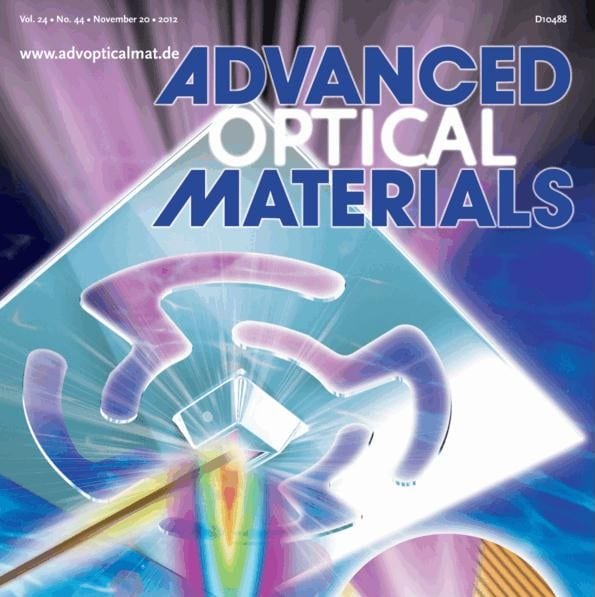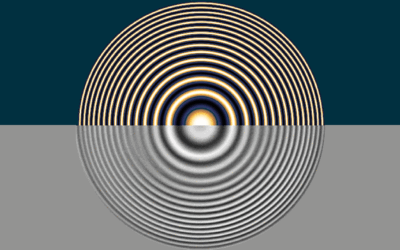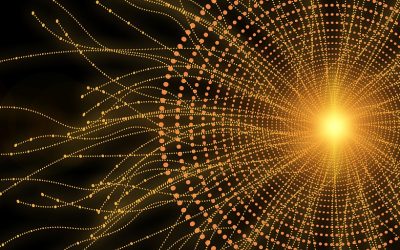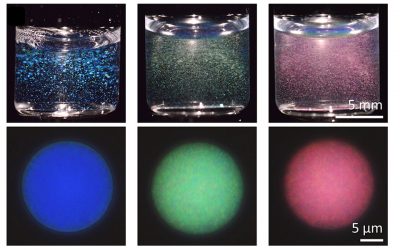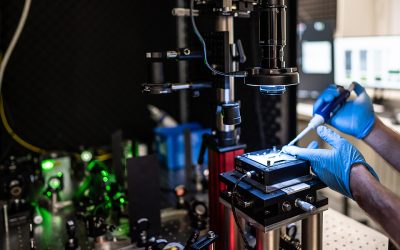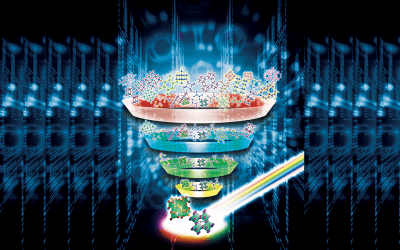 Advanced Optical Materials section, Issue 4 is now live, with nine contributions from a range of leading research groups and covering the whole spectrum of light–matter interactions.
Advanced Optical Materials section, Issue 4 is now live, with nine contributions from a range of leading research groups and covering the whole spectrum of light–matter interactions.
All articles will be free to access for a limited amount of time.
To contribute a paper to one of the first issues of the new Advanced Optical Materials journal, visit http://www.advopticalmat.de/call-for-papers/ .
Cover Picture: Advanced Optical Materials
Lithography: Resolution Limit in Plasmonic Lithography for Practical Applications beyond 2x-nm Half Pitch (Adv. Mater. 44/2012) (page OP273)Seok Kim, Howon Jung, Yongwoo Kim, Jinhee Jang and Jae W. Hahn
Article first published online: 20 NOV 2012 | DOI: 10.1002/adma.201290284
The ultimate resolution of plasmonic lithography using a ridge aperture is evaluated using a theoretical model by Jae W. Hahn and co-workers on page OP337. A circular contact probe with high positioning accuracy is fabricated to record high density line array patterns with a half pitch up to 22 nm. The model fits well with the experimental results for pattern depth and predicts the resolution of plasmonic lithography to be less than 10 nm.
Inside Front Cover: Advanced Optical Materials
Invisibility Cloaking: Invisibility and Cloaking Based on Scattering Cancellation (Adv. Mater. 44/2012) (page OP274)Pai-Yen Chen, Jason Soric and Andrea Alù
Article first published online: 20 NOV 2012 | DOI: 10.1002/adma.201290285
The exciting area of invisibility cloaking is reviewed by Andrea Alù and co-workers on page OP281. Various solutions for invisibility cloaking using metamaterials, metasurfaces, graphene and plasmonic materials in different spectral ranges are discussed. Particular focus is placed on scattering-cancellation approaches, highlighting material challenges, venues and opportunities for plasmonicand mantle-cloaking techniques, in various frequency windows, and for several devices and applications.
Back Cover: Advanced Optical Materials
Carbon Nanotubes: Carbon Nanotube Based High Resolution Holograms (Adv. Mater. 44/2012) (page OP356)Haider Butt, Yunuen Montelongo, Tim Butler, Ranjith Rajesekharan, Qing Dai, Sai G. Shiva-Reddy, Timothy D. Wilkinson and Gehan A. J. Amaratunga
Article first published online: 20 NOV 2012 | DOI: 10.1002/adma.201290286
By using carbon nanotubes as the smallest possible scattering element, light can be diffracted in a highly controlled manner to produce a 2D image, as reported by Haider Butt and co-workers on page OP331. An array of carbon nanotubes is elegantly patterned to produce a high resolution hologram. In response to incident light on the hologram, a high contrast and wide field of view “CAMBRIDGE” image is produced.
Contents: (Adv. Mater. 44/2012) (pages OP276–OP278)Article first published online: 20 NOV 2012 | DOI: 10.1002/adma.201290288
Advanced Optical Materials reaches the next level (pages OP279–OP280)Tim Adams and Eva Rittweger
Article first published online: 20 NOV 2012 | DOI: 10.1002/adma.201204367
Invisibility and Cloaking Based on Scattering Cancellation (pages OP281–OP304)Pai-Yen Chen, Jason Soric and Andrea Alù
Article first published online: 19 OCT 2012 | DOI: 10.1002/adma.201202624
Various solutions for invisibility cloaking using metamaterials, metasurfaces, graphene and plasmonic materials in different spectral ranges are reviewed. The primary focus of this Review is on scattering-cancellation approaches, highlighting material challenges, venues and opportunities for plasmonic- and mantle-cloaking techniques, in various frequency windows, and for several devices and applications.
Anisotropic Resonant Scattering from Polymer Photonic Crystals (pages OP305–OP308)Andrew I. Haines, Chris E. Finlayson, David R. E. Snoswell, Peter Spahn, G. Peter Hellmann and Jeremy J. Baumberg
Article first published online: 23 AUG 2012 | DOI: 10.1002/adma.201202169
Hyperspectral goniometry reveals anisotropic scattering which dominates the visual appearance of self-assembled polymer opals. The technique allows reconstruction of the reciprocal-space of nanostructures, and indicates that chain defects formed during shear-ordering are responsible for the anisotropy in these samples. Enhanced scattering with improving order is shown to arise from increased effective refractive index contrast, while broadband background scatter is suppressed by absorptive dopants.
Solid Immersion Facilitates Fluorescence Microscopy with Nanometer Resolution and Sub-Ångström Emitter Localization (pages OP309–OP313)Dominik Wildanger, Brian R. Patton, Heiko Schill, Luca Marseglia, J. P. Hadden, Sebastian Knauer, Andreas Schönle, John G. Rarity, Jeremy L. O’Brien, Stefan W. Hell and Jason M. Smith
Article first published online: 12 SEP 2012 | DOI: 10.1002/adma.201203033
Exploring the maximum spatial resolution achievable in far-field optical imaging, we show that applying solid immersion lenses (SIL) in stimulated emission depletion (STED) microscopy addresses single spins with a resolution down to 2.4 ± 0.3 nm and with a localization precision of 0.09 nm.
Excitation Enhancement of a Quantum Dot Coupled to a Plasmonic Antenna (pages OP314–OP320)Esteban Bermúdez Ureña, Mark P. Kreuzer, Stella Itzhakov, Hervé Rigneault, Romain Quidant, Dan Oron and Jérôme Wenger
Article first published online: 2 OCT 2012 | DOI: 10.1002/adma.201202783
Plasmonic antennas are key elements to control the luminescence of quantum emitters. However, the antenna’s influence is often hidden by quenching losses. Here, the luminescence of a quantum dot coupled to a gold dimer antenna is investigated. Detailed analysis of the multiply excited states quantifies the antenna’s influence on the excitation intensity and the luminescence quantum yield separately.
Circular Dichroism from Chiral Nanomaterial Fabricated by On-Edge Lithography (pages OP321–OP325)Kay Dietrich, Dennis Lehr, Christian Helgert, Andreas Tünnermann and Ernst-Bernhard Kley
Article first published online: 8 OCT 2012 | DOI: 10.1002/adma.201203424
A novel-shaped plasmonic chiral nanomaterial exhibiting circular dichroism in the near-infrared spectral range is presented. Applying on-edge lithography, a large area with these nanostructures is efficiently covered. This fabrication method offers tunability of the operation bandwidth by tailoring the chiral shape.
High-Optical-Quality Blends of Anionic Polymethine Salts and Polycarbonate with Enhanced Third-Order Non-linearities for Silicon-Organic Hybrid Devices (pages OP326–OP330)Zhong’an Li, Yang Liu, Hyeongeu Kim, Joel M. Hales, Sei-Hum Jang, Jingdong Luo, Tom Baehr-Jones, Michael Hochberg, Seth R. Marder, Joseph W. Perry and Alex K.-Y. Jen
Article first published online: 23 JUL 2012 | DOI: 10.1002/adma.201202325
A series of anionic polymethine dyes with different aromatic counterions are prepared to improve their compatibility as guests in an amorphous polycarbonate host. When they are used as the cladding material for silicon hybrid slot waveguides, four-wave mixing wavelength conversion and two-photon absorption-based optical-power modulation are observed. Such guest-host materials may be attractive candidates for all-optical signal-processing applications.
Carbon Nanotube Based High Resolution Holograms (pages OP331–OP336)Haider Butt, Yunuen Montelongo, Tim Butler, Ranjith Rajesekharan, Qing Dai, Sai G. Shiva-Reddy, Timothy D. Wilkinson and Gehan A. J. Amaratunga
Article first published online: 31 AUG 2012 | DOI: 10.1002/adma.201202593
Carbon nanotubes are used as the smallest possible scattering element for diffracting light in a highly controlled manner to produce a 2D image. An array of carbon nanotubes is elegantly patterned to produce a high resolution hologram. In response to incident light on the hologram, a high contrast and wide field of view CAMBRIDGE image is produced.
Resolution Limit in Plasmonic Lithography for Practical Applications beyond 2x-nm Half Pitch (pages OP337–OP344)Seok Kim, Howon Jung, Yongwoo Kim, Jinhee Jang and Jae W. Hahn
Article first published online: 8 OCT 2012 | DOI: 10.1002/adma.201203604
The ultimate resolution of plasmonic lithography using a ridge aperture is evaluated with a theoretical model. A circular contact probe with high positioning accuracy is fabricated to record high-density line array patterns with a half pitch of up to 22 nm. The model fits well with the pattern depth experimental results and predicts a resolution for plasmonic lithography to less than 10 nm.
Photoalignment and Surface-Relief-Grating Formation are Efficiently Combined in Low-Molecular-Weight Halogen-Bonded Complexes (pages OP345–OP352)Arri Priimagi, Marco Saccone, Gabriella Cavallo, Atsushi Shishido, Tullio Pilati, Pierangelo Metrangolo and Giuseppe Resnati
Article first published online: 18 OCT 2012 | DOI: 10.1002/adma.201204060
An unprecedented optical performance is reported for a novel photoresponsive supramolecular liquid-crystalline complex, self-assembled through halogen bonding between a non-mesogenic stilbazole derivative, acting as a bond acceptor, and a non-mesogenic bond donor containing an azo-group. Efficient photoalignment and an exceptional surface-relief-grating formation are combined in this low-molecular-weight supramolecular assembly, thanks to the high directionality of the halogen bond.

